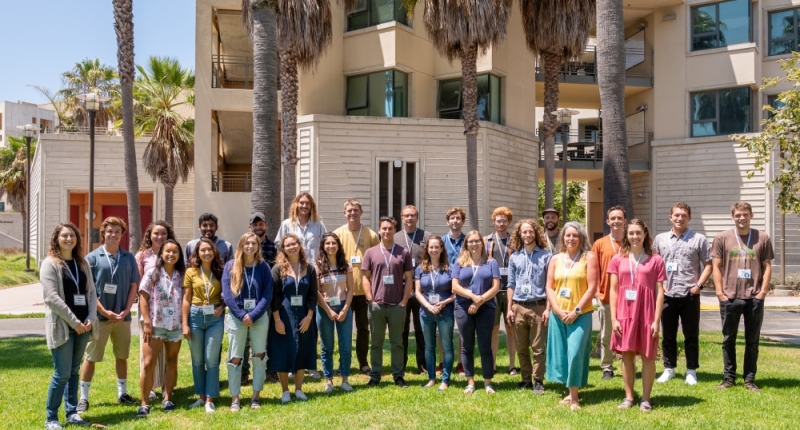Master’s program in environmental data science wraps up a promising first year

This story is cross posted from an original press release in The Current.
It’s a major milestone for the Master of Environmental Data Science (MEDS) program at UC Santa Barbara, as the first cohort of MEDS students presents its capstone projects. The public is invited to this inaugural event taking place from 1 p.m. to 5 p.m. Thursday, May 26, in Bren Hall 1414 and on Livestream.
MEDS aims to prepare scientists for the new wave of data-driven research and environmental problem solving. The program is a joint effort between UCSB’s Bren School of Environmental Science & Management and the National Center for Ecological Analysis and Synthesis (NCEAS).
“It is simply wonderful to see an idea, first hatched nearly seven years ago, come to fruition,” said NCEAS executive director and Bren professor Ben Halpern.
MEDS is half the length of Bren’s Master of Environmental Science & Management (MESM) program, which presented different opportunities and challenges when it came to the capstone project. “We’re learning how a six-month project works,” said MEDS program coordinator Jamie Montgomery. “What’s feasible with these students and the skills that they‘ve acquired?”
The program’s first 25 students arrived in August, 2021 for a six-week intensive session on scientific programming at NCEAS’s new downtown location. It was an immersive experience for the group, who all came with environmental backgrounds but varying levels of programming proficiency. With no homework, and few grades, the crash course engendered a lot of camaraderie within the class.
The next three quarters of courses were split between downtown and main campus, with half the week at NCEAS and the other half in Bren Hall. Come winter, the students split into seven groups to begin their capstone projects. Because of the focus on data science and a shorter 1-year program, many of this year’s teams focused on data visualization.

Photo Credit: JAMIE MONTGOMERY
One team is creating an interactive visualization of data collected in Moorea, French Polynesia, where many UC Santa Barbara researchers conduct field work. “Beyond the technical takeaways, I have really enjoyed the collaboration experience with my group and our advisors,” said MEDS student Felicia Cruz. “This capstone project has shown me the importance of clean workflows, team communication and organization that will be crucial for success in a future environmental data science career.”
Cruz feels the program does a good job balancing hard and soft skills she and her classmates need to master. “I think the program definitely helps shape us professionally just as much as it does technically,” she said, “which is important in the ecological research community.”
Half of the 2022 class has already secured post-graduate positions, including jobs, fellowships and spots in doctoral programs. It’s a testament to the students’ abilities, the demand for environmental data scientists and the esteem of UC Santa Barbara’s Bren School within the environmental science community.
Indeed, the MEDS program is part of a growing trend transforming Santa Barbara into an environmental data science hub. The program was conceived by Professor Halpern, who has helped maintain NCEAS as a leader in environmental data science.
“Launching a new program is a truly team effort,” Halpern said. “This first year of MEDS was, by nearly any measure, a huge success, and everyone deserves credit for making that happen.”
Environmental data science has become ubiquitous at UC Santa Barbara from geography groups like the Climate Hazards Center and SPAR Lab to biologists working at the Long Term Ecological Research sites. In 2015, researchers across campus established EcoDataScience, a volunteer-driven study group that offers workshops on various data science tools relevant to environmental science and has been copied at campuses around the world.
“There are all these things happening to launch UCSB, and hopefully Santa Barbara, as an environmental data science hotspot,” Montgomery said.
“It's been a very busy and incredibly rewarding first year for MEDS. We were ready for challenges that might come with launching a brand new program (especially during a pandemic) but I have to say it has been much smoother than expected.”
Montgomery is proud of the initiative demonstrated by the students, faculty and staff. “A big win is the amount of student feedback we’ve gotten and our ability to adapt, even within the same year,” she said.
Next year’s cohort will comprise 31 students. “Almost 70% are women,” Montgomery said, “and that’s reflective of the application pool.” And that’s a big deal, she pointed out, because data science has a significant gender gap. “One thing we’re excited about with MEDS is the opportunity to improve diversity in the environmental data science field.” The school plans to grow the program to 75-80 students within five years.
“I have really enjoyed watching the students learn and grow as environmental data scientists,” Montgomery said. “I can't wait to see what they all do next!”
Contact Info:
Harrison Tasoff
(805) 893-7220
harrisontasoff@ucsb.edu
